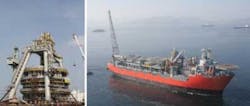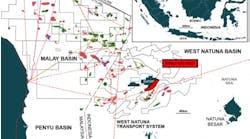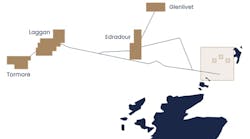Turret moorings evolve to accommodate complex subsea spreads, harsher environments
Leen Poldervaert
SBM Offshore
The turret concept to free weathervane moor vessel-based floating production and storage systems (FPSOs/FSOs) was pioneered in the early 1980s by SBM Offshore. Since then, that idea has evolved to meet more rigorous operations demands.
In essence, a turret mooring system comprises a fixed turret column held by an internal or external vessel structure via a bearing arrangement. Therefore the vessel-bound components can weathervane freely around the turret which is fixed via a number of anchor lines with respect to the seabed. This arrangement allows the FSO/FPSO to adopt the direction of least resistance against waves, wind, and currents.
On top of the fixed turret column, and above the vessel deck level, is an open structure allowing manifolding of the fluids (oil, gas, water). Above this structure, a toroidal fluid swivel allows for transfer of fluids across the rotary turret interface while the FSO/FPSO freely weathervanes.
The turret column is secured to the seabed by (catenary) anchor legs that help maintain the vessel within a design excursion limit. This excursion limit ensures safe operation of the underwater fluid transfer or riser system from seafloor to turret. Turret concepts come in a number of different design layouts, but all use catenary or, in deep waters, (semi-) taut mooring lines.
Free weathervane turrets include those designed to permanently moor the vessels in survival conditions such as:
- External turrets for mild to medium environments
- Internal turrets for harsh environments (i.e. west of Shetlands, North Sea)
- Internal turrets for a large number of flow lines and risers.
Deployment of FPSOs in certain tropical storm areas or in fields where winter ice may form has led to the requirement for a disconnectable mooring system to allow the FPSO to sail away from the site without external assistance while leaving the mooring system behind. Another advantage of the disconnectable mooring is that the FPSO can sail easily to a shipyard for upgrading or routine inspections and stationary surveys.
Since those early days, further technology developed to meet industry demands for turret mooring systems equipped to handle larger vessels with increased numbers of risers, in varying water depths, and for environments worldwide.
External turret moorings
In 1985, SBM developed and fitted its first external turret mooring system to the stern of the 140,000 dwt FSOAlba Marina. The system comprises a steel box-type structure that can either be close to or extended some distance from the bow or stern of the vessel, providing a foundation for a rotating bearing arrangement and a turret structure located above water. The bearing accommodates an earth “fixed” chain table to which mooring legs and fluid transfer hoses are attached.
Chain legs fasten to the seabed either by anchors or piles. Product and utility connections are effected between the facilities on the vessel and the seabed via a swivel stack on the turret, allowing the vessel to weathervane freely around the fixed part while continuing production. An alternative design is the clamped bow turret where the rotating bearing arrangement is split between an above and below water section.
Internal turret moorings
An internal turret mooring system is integrated into the forward end of a vessel and is supported on a large bearing arrangement on either inside a moon pool towards the keel, or at deck level.The tailor-made free weathervane FPSO turret mooring system is designed to moor the vessel in all weather conditions up to and including the survival sea state.
An internal turret consists of a chaintable structure anchored to the seabed via an array of mooring anchor lines. The chaintable suspends from a heavy duty roller-bearing located several meters above the keel of the FPSO and supported by an innovative support to decouple the vessel local deformations from the ring type bearing box structure. A radial assembly is used at the vessel main deck level to absorb the radial loads caused by accelerations of the upper turret structural mass.
The turret cylinder houses the riser “I-tubes” and supports the turret main deck, the manifold platform, the swivel stack, riser winches, and all fixed portions of the rigid piping. The
Anasuria-type turret is designed to accommodate up to 14 risers of various diameters. In 1994, SBM Offshore was awarded the first free weathervane FPSO for a North Sea location. Shell’s Anasuria FPSO was a newbuild turret moored monohull vessel with a storage capacity of 850,000 bbl, designed for continuous operation and a 20-year service life in a harsh UK North Sea environment.
Another breakthrough in turret technology came in the late 1990s when Petrobras commissioned mooring for two large FPSOs in deep waters offshore Brazil. The challenge was to accommodate 35 and 47 risers, respectively, in two weathervaning FPSOs. The swivel stacks used are among the largest in the industry, with up to 12 individual passes.
Later, this same technology was applied to the 285,000 dwtEspadarte FPSO where the turret system accommodates 45 risers, servicing up to 15 production and nine water injection wells.
In 1996, SBM Offshore was contracted to design and supply a turret mooring system suitable to moor a 154,000 dwt FPSO for 25 years of continuous service in the ultra-harsh environment west of the Shetlands. The Top Mounted Internal Turret (TMIT) is sized to incorporate up to 24 risers and incorporates two innovative features: a bogie wheel system replacing the usual main bearing system, and an inverted swivel stack.
The fixed part of the turret comprises a 14-m (46-ft) diameter cylinder inserted into the vessel hull and supported at deck level by 20 vertical and 18 radial bogie wheel assemblies that provide the interface between the fixed turret column/manifold piping and the weathervane vessel. The vertical bogies and radial wheels run on bolted and sectioned rails. All components can be replaced in situ if necessary.
Vertical bogie/horizontal wheel numbers can be adapted easily to meet different survival and fatigue load requirements. Various turret moorings of the bogey type have been installed since, and SBM Offshore currently has a contract to supply another large bogey turret mooring for a replacement FPSO installation west of the Shetlands.
The bogey turret also can be adapted to suit the required number of flow lines and risers. Several bogey bearing turret mooring systems have been delivered, including in 2005 a converted 322,000 dwt floating production unit carrying 75 risers. In addition, the large diameter turret provides extra space during hook-up for risers and mooring installation.
Recently, SBM supplied and installed the Skarv FPSO turret mooring system, also based on the bogie wheel design. This FPSO will be located in a very harsh environment in the Norwegian Sea.
Disconnectable turret moorings
The concept of disconnectable turret mooring systems was developed in the early 1980s. These systems allow production of reserves in regions prone to severe conditions such as typhoons, hurricanes, or ice packs, which might threaten the safe operation of the facility. The concept evolved in 1985 when SBM Offshore supplied an external disconnectable Riser Turret Mooring (RTM) system for a 160,000 dwt FPSO, theJabiru Venture, operating in a cyclone-prone region off the northwest coast of Australia.
During the late 1980s, the company developed an internal disconnectable Buoyant Turret Mooring (BTM) system was developed and installed for theNan Hai Fa Xian, a 250,000 dwt FPSO stationed off Hong Kong in the typhoon-affected environment of the South China Sea. In 2002, the newly built Sea Rose FPSO working offshore eastern Canada was also furnished with a BTM.
Bow-mounted riser turret mooring system.
The first of these concepts comprises a vessel bow mounted riser turret, incorporating a rapid and independent disconnectable RTM. Disconnection is achieved automatically in two stages. First, the fluid risers are isolated and disconnected, and then the mooring riser column is disengaged using large hydraulically operated collet-type connectors. Following disconnection, the riser column remains on location, and the vessel sails away. When the vessel returns, the riser column is pulled up to the bow and reconnected.
A BTM system comprises an internal turret into the forward end of a vessel. The mooring buoy is connected to an internal turret structure by a large connector. The buoy is designed to provide sufficient buoyancy to support the weight of the mooring legs and risers.
During a disconnection, the mooring buoy will fall away from the keel of the vessel and stabilize at a water depth of around 35 m (115 ft) below mean sea level. To reconnect, the mooring buoy is pulled up under the vessel using a wire rope hauled in on a drum winch.
Offshore Articles Archives
View Oil and Gas Articles on PennEnergy.com







